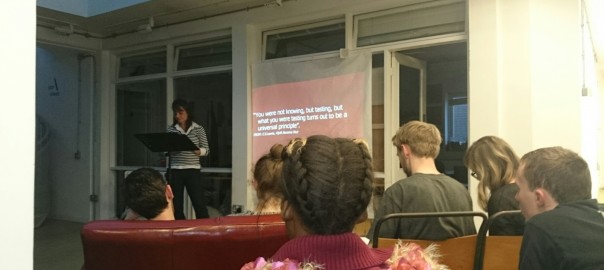 Over the last few months, I’ve started getting involved in Morphe Arts group, especially the writers’ group that meets in the Southbank Centre twice a month. They recently produced the first issue of their literary magazine Margins and I’ve contributed a short story, The Wordless to the website.
Over the last few months, I’ve started getting involved in Morphe Arts group, especially the writers’ group that meets in the Southbank Centre twice a month. They recently produced the first issue of their literary magazine Margins and I’ve contributed a short story, The Wordless to the website.
Morphe also has monthly meetings covering a range of stuff in the arts generally, and this Monday was a lecture by Edith Reitsma from L’Abri Fellowship. I’ve met and heard talks by Edith several times – she was one of the speakers at the Christian Postgraduate Conference back in 2011 and helped me when I was thinking through a Christian perspective on literature when I visited L’Abri during my degree. Her talks are always warm, engaging and deep.
So I was really excited that she was speaking on “how the imagination engages the heart”. Understanding the imagination better is a fascinating and challenging task, especially for those engaged in creating art.
It also seems particularly relevant to the debate that Richard Dawkins sparked over the role of fairy-stories. He was misquoted as saying that children shouldn’t be read fairy-tales, leading to a widespread outcry in their defence and in the defence of imagination. He had in fact voiced his opposition to children being taught to believe in Santa or the Tooth Fairy as real, since it has the danger of inculcating supernaturalism, and raised the question of fairy stories – though he later clarified that he thought on balance they probably help to develop critical thinking.
What follows are my notes on the talk, along with some of my thoughts and reactions [in square brackets], especially when I spotted connections with other ideas and writers. I believe that the talk was recorded, so hopefully it will appear online soon.
Introduction
For C S Lewis, rationality alone wasn’t enough to win him to Christ – it was also a question of meaning and imagination. As Alistair McGrath observed in C S Lewis: A Life:
Tolkien thus helped Lewis to realise that a “rational” faith was not necessarily imaginatively and emotionally barren. When rightly understood, the Christian faith could integrate reason, longing, and imagination.
But how is it that imagination engages us with reality? Tolkien and Lewis were deeply aware of the power of myth. Whether something appeal to our heart depends on it catching hold of the imagination.
[Both Tolkien and Lewis were influenced in these respects by Owen Barfield’s ideas of language – his book Saving the Appearances explores how the way we relate to symbols and use them to engage with reality has changed over time. It’s a hard read, but a fascinating one.]
1) How historically did we as people lose appreciation for the mystery of our world?
Very broadly: Modernistic humanism elevated abstract, controlled and autonomous reason. Romanticism in reaction to modernism sought to reaffirm emotion’s centrality to life. Postmodernism rejected overarching objective reason. Today we long for a sense of overarching meaning – we have a craze for facts but a loss of wonder.
[Neil Postman’s book Technopoly argues that our use of computers and the mass media gives us an information overload that leaves no room for overarching meaning or for wonder. He blames our cultural changes on the use of technology, which is certainly partly true, but doesn’t engage so much with how that is driven by pre-existing cultural trends such as those mentioned above]
Einstein said that:
“Imagination is more important than knowledge. For knowledge is limited to all we now know and understand, while imagination embraces the entire world, and all there ever will be to know and understand.”
Facts are miracles in that they are wonderful and purposeful. Life is a story, so there must be a storyteller.
G K Chesterton wrote in Orthodoxy about the two lessons that fairy-tales taught him:
First, that this world is a wild and startling place, which might have been quite different, but which is quite delightful; second, that before this wildness and delight one may well be modest and submit to the queerest limitations of so queer a kindness.
2) Moralism vs Moral Imagination
How does the imagination affect our approach to morality? Abstract rationalism apart from relationships leads to moralism, which only produces shame, not transformation. Abstract rules seem dead and manipulative.
Whereas older thinkers talked about “moral virtues”, we now talk about “moral values”. The idea of “values” suggests that morality is something than emanates from us – morality is what we personally value, rather than an objective standard outside of us. Possibly the first person to talk about “values” in this way was Nietzsche, who wrote in Beyond Good and Evil:
“The noble type of man regards HIMSELF as a determiner of values; he does not require to be approved of; he passes the judgment: “What is injurious to me is injurious in itself;” he knows that it is he himself only who confers honour on things; he is a CREATOR OF VALUES.”
By contrast, moral imagination connects morality with our relationships – our relationship with God, and our relationships with others.
Vigen Guroian writes in Tending the Heart of Virtue: How Classic Stories Awaken a Child’s Moral Imagination about George MacDonald’s view of the imagination:
“Reason alone, MacDonald argued, is not able to recognize mystery or grasp the moral quiddity of the world. As the sensible mind needs eyes to see, so reason needs the imagination in order to behold mystery and to perceive the true quality of things. Imagination takes reason to the threshold of mystery and moral truth and reveals them as such.”
In a good story, the imagination:
- Attunes us to our emotions
- Depicts right and wrong, and the struggle between them
- Engages the heart
- Forces us to make moral decisions, stimulating thought
Bruno Bettelheim said in The Uses of Enchantment:
“It is not the fact that virtue wins out at the end which promotes morality, but that the hero is most attractive to the child, who identifies with the hero in all his struggles.”
Vigen Guroian again:
“The safety and assurance of these imaginative adventures is that risks can be taken without having to endure all of the consequences of failure; the joy is in discovering how these risky adventures might eventuate in satisfactory and happy outcomes. Yet the concept of self is also transformed.”
For example, Carlo Collodi’s Pinocchio allows the child reader to vicariously experience Pinocchio’s transformation from a puppet into a real and a good boy. In the Disney version, it is Geppetto who wishes for Pinocchio to become a real boy, and Jiminy Cricket acts as his conscience – the moral change comes from outside and seems manipulative. By contrast, in the book, Pinocchio himself is the one who wishes to be a real boy, and the moral change is internal.
Imagination allows you to identify with the story, to see how your own situation may be like it, and to have your sense of reality and truth heightened. By identifying with Pinocchio imaginatively, we share in his moral journey.
3) The need for Moral Imagination in relationships
We don’t ask, “do I want to be good?” but “who do I want to be?” [That is, we don’t desire to be good in abstract, but to be like particular people – to be Luke Skywalker or Princess Leia, and so on]
Flannery O’Connor said,
“A story is a way to say something that can’t be said any other way, and it takes every word in the story to say what the meaning is.”
Our primary relationship is with God, and we need imagination to see how to live it out. Moral imagination is using your imagination to fully comprehend the difference between good and evil in light of your relationship with God, who is the greatest good.
4) The need for imagination enlightened by the Holy Spirit
Imagination needs to be connected to truth. A good example of the imagination communicating truth is when the prophet Nathan confronted King David about his adultery with Bathsheba. He didn’t accuse David directly at first, but told a parable, a story, engaging David’s imagination. Through David’s imagination, his sense of reality and truth were linked by the Holy Spirit, awakening his deadened sense of compassion and justice.
Stories awake compassion in us by binding us to the suffering of others, moving us to action. The Holy Spirit works through this to change our hearts.
Discussion
After Edith finished her talk, it was opened up for discussion. Many in the room were visual artists who wanted to know how this related to non-narrative art. Edith talked about how part of our story is wonder and delight, and we don’t have a responsibility to be constantly explaining what we’re doing – we can just get on with being co-creators and exploring the world imaginatively.
Limits of imagination?
Another question that came up was with the limits of imagination – can imagination run wild in a dangerous or bad way? Does imagination being connected with truth mean it has to be “realist” to some degree? What emerged from the discussion was that it’s not what your story contains, but the moral attitude it encourages. For example, if your story is about adultery, does it make it seem attractive or expose its ugliness? In terms of truthfulness, that doesn’t mean “realism”, but it does mean saying something true about the world or our human experience, no matter how wild and fantastic the story that expresses those things.
Moral or immoral stories?
We also talked about how it’s quite unfashionable it is to talk about moral imagination and art being morally good or morally bad. Oscar Wilde said “There is no such thing as a moral or an immoral book. Books are well written, or badly written. That is all.” That’s clearly not all, but we shouldn’t ignore whether something is well written or badly written either. We shouldn’t give stories a free pass on bad writing for having a good moral theme; and we should appreciate good craft even when it is misdirected.
Also, we need to engage with art that expresses viewpoints different from our own, but to be very aware of the impact it has on shaping our imaginations. Art is a relationship, not a commodity – so that means that as with people, we need to engage with all sorts. But we also need to choose friends and community that are a good and stable influence on us.
Virtue and story
Thinking about the talk afterwards, I was reminded of Alistair MacIntyre’s book After Virtue. In our culture, we have largely abandoned the idea of a universal endpoint of the good life that gives a shared moral and ethical structure from childhood through adulthood through old age and death. Instead, our endpoint is much sooner and more limited: we receive moral instruction in childhood, but the endpoint is being becoming a rational, autonomous adult who makes their own values, like Nietzsche’s “noble man”.
This fragments both our society’s moral discourse, which becomes just the increasingly shrill assertion of personal preferences, and also our sense of selfhood as we move through life: childhood and old age as split off and treated as very distinct stages.
MacIntyre argues that we need to recover our sense of moral virtue – goodness not as fixed rules or subjective preferences, but character as it grows and develops over the course of one’s life. Moral imagination is needed not only for art, but for us to live the stories of our lives.
So all in all a fascinating, thought-provoking evening! Let me know your thoughts below.


